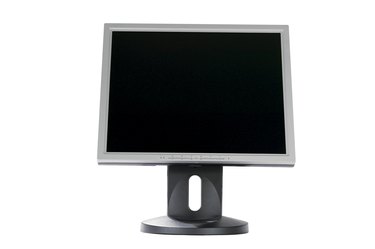
A screen that gets gradually dimmer, a monitor that flickers when you turn it on, or a display that flashes before going dark are all indicative of an LCD with a failing backlight. Most LCD screens require a third-party backlight, so at some point, you'll need to deal with lamp failure for your screen.
Types of Backlights
Video of the Day
The liquid crystals that form the pixels on an LCD monitor are transmissive. This means they lack the ability to illuminate themselves and require a third-party backlight. LCD screens use two types of lamps for light. The first is an LED backlight. Short for light-emitting diode, an LED lamp has a lifespan of up to 50,000 hours. The less energy efficient type of backlight is the cold-cathode fluorescent lamp, or CCFL. CCFL backlights last between 20,000 and 40,000 hours. With the average LCD monitor lasting up to 100,000 hours, it's more than likely you'll have to replace your backlight before you replace your screen, regardless of what type of lamp your device requires.
Video of the Day
Dim Screen
One of the three major signs of backlight failure is a dim LCD screen. If you notice your LCD has a screen that seems dark, check your brightness and contrast settings on your monitor. If increasing those settings does not brighten the screen, or only brightens it temporarily, the lamp that illuminates your screen is probably failing.
Flickering Screen
A second key symptom of a failing lamp is a screen that flickers. Just as with a dim screen, a dying backlight isn't the only potential cause of this issue. Check the power cord and other cables attached to your television to ensure that signal interruption or a break in the power circuit isn't the source of the problem.
Black Screen
The third major sign of a dying backlight is a monitor that turns on, but only for a second, before turning to black. In this case, your television is still on; its backlight is not illuminating the screen, resulting in the darkness. You'll be able to hear the audio, but you won't see any images. Check the power source to make sure all plugs are correctly attached.
Fix Lamp
You can replace a dead or dying backlight. This process requires not only electrical expertise, but also experience with soldering. Replacement should only be undertaken by a professional, or an individual with professional-level skills. If replacing your dying lamp doesn't result in a strong, stable light source, the inverter may be the source of the problem. An inverter supplies the power to both LED and CCFL lights. When it fails, the flow of power is interrupted, producing the same symptoms as a failing lamp.